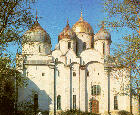St Sophia's Cathedral
 The St Sophia's Cathedral was built between 1045- 1050 inside the Detinets. It is one of the earliest stone structures of northern Russia, a senior contemporary of Notre Dame in Paris, and the cathedrals of Rheims, Amiens, Bamberg and Naumburg. Its height is 38 m. Originally it was taller, for during the past nine centuries the lower part of the building became concealed by the two-metre thick cultural layer. The cathedral was built by Prince Vladimir, the son of Yaroslav the Wise, and until the 1130s this principal church of the city also served as the sepulchre of Novgorodian princes. For the Novgorodians, St Sophia became synonymous with their town, the symbol of civic power and independence.
The St Sophia's Cathedral was built between 1045- 1050 inside the Detinets. It is one of the earliest stone structures of northern Russia, a senior contemporary of Notre Dame in Paris, and the cathedrals of Rheims, Amiens, Bamberg and Naumburg. Its height is 38 m. Originally it was taller, for during the past nine centuries the lower part of the building became concealed by the two-metre thick cultural layer. The cathedral was built by Prince Vladimir, the son of Yaroslav the Wise, and until the 1130s this principal church of the city also served as the sepulchre of Novgorodian princes. For the Novgorodians, St Sophia became synonymous with their town, the symbol of civic power and independence.
The five-domed church looks simpler but no less impressive than its prototype, the thirteen-domed St Sophia of Kiev. The cathedral exterior is striking in its majesty and epic splendour evoking the memories of Novgorod's glorious past and invincible might. In the 11th century it looked more imposing than now. Its facade represented a gigantic mosaic of huge, coarsely trimmed irregular slabs of flagstone and shell rock. In some places (particularly on the apses), the wall was covered with mortar, smoothly polished, drawn up to imitate courses of brick or of whitestone slabs, and slightly coloured. As a result, the facade was not white, as it is today, but multicoloured. The play of stone, decorative painting and the building materials of various texture enhanced the impression of austere simplicity and introduced a picturesque effect.
The two-storied galleries extend along the building's southern, western and northern sides, with a stair-tower constructed at the north-eastern corner. The cathedral has three entrances - the southern, western and northern, of which the western was the main one intended for ceremonial processions. A gate standing at the entrance is known as the Sigtuna Gate (mid-12th century); according to legend, it was brought from the Swedish town of Sigtuna in 1187. The second name of the gate derives from the town of Magdeburg, where it was made. The two leaves are decorated with biblical and evangelical scenes in cast bronze relief. In the lower left corner there are portraits of the craftsmen who created this superb specimen of medieval Western European bronze-work. An inscription in Latin gives their names, Riquin and Weissmut. The small central figure - judging from an inscription in Slavonic - is a representation of the Russian master craftsman Avraam, who assembled the gate.
There is yet another bronze gate in the cathedral, called the Korsun Gate. Made in the 11th century in Chersonesos, Byzantium, it leads from the southern gallery into the Nativity Side-Chapel. Legend has it that the gate was handed over to Novgorod as a gift of Prince Yaroslav the Wise (c. 978 - 1054).
The interior of the cathedral is as majestic as its exterior. It is divided by huge piers into five aisles, three of which end in altar apses. In the south-western corner, inside the tower, there is a wide spiral in relatively small, modest buildings of the 12th - 16th centuries.